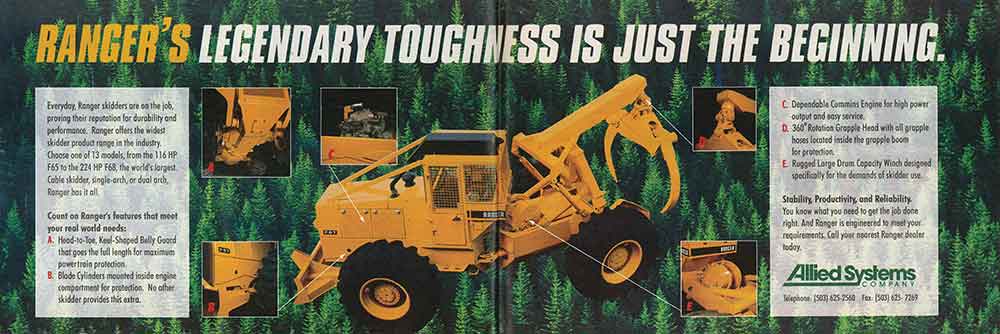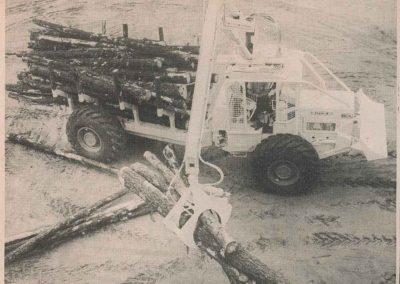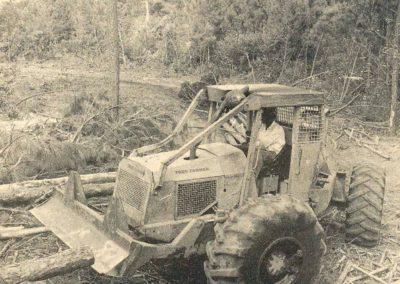October 2022
Southern Loggin’ Times marks the 50th anniversary of our first issue, published in October 1972. Central to this special commemorative issue, SLT co-founder and former co-publisher DK Knight returns to bring you this meticulously researched timeline of the industry’s history in this region.
Inside This Issue
COVER: 50-Year Timeline
October 1972 is the birth month of Loggin’ Times, as it was then known. To help commemorate the magazine’s 50-year anniversary, SLT offers an accompanying and interesting Southern forestry industry timeline. But before that year-by-year review begins, it’s fitting to consider some key developments and trends that occurred after WWII and in the ’50s, ’60s and early ’70s.
Article by DK Knight, Publisher/Editor Emeritus, Southern Loggin’ Times
SOUTHERN STUMPIN': SLT & Me
In October 1972 Bill Abbott and his young bride Sherry had been married for five years. They were just moving into a new house they’d built on Peachtree Street in Millbrook, Alabama, a then very undeveloped bedroom community just north of Montgomery. They didn’t have any children yet, but they thought this would be a nice place to plant roots and raise a family. Two years earlier they’d left their home in Arkansas, convinced by salesman Kit Avery to come work with him at Timberjack’s store in Montgomery.
Article by David Abbott, Managing Editor, Southern Loggin’ Times
COVERS GALLERY
Five Decades Covered
SLT And You
We asked y’all for reader participation, and you sure as heck delivered. In fact you delivered so much that unfortunately we just don’t have room to include everything we received from everybody who responded, but we think you’ll enjoy reading what we have been able to fit in.
BULLETIN BOARD CLASSICS
Our Best Leisure Selections From Our Not-So-Sharp Minds
ADVERTISER ALLEY
SLT Sponsors’ Stories
SLT SCRAPBOOK
Through The Years
INDUSTRY NEWS ROUNDUP
- As We See It – Mature & Old-Growth: Defining Ambiguity
- Peak Renewables Plans Pellet Facility
- Enviva Addresses Property Loss
- Enviva Continues Growth Expansion
- Strategic Biofuels Gains Support
- Bob Vermeer Guided Family Operation
50 Years: 1972-2022
PLEASE NOTE: Only a limited amount of each issue is available to preview on the website. If you would like to view the full issue in digital or print form, you can subscribe here. Subscriptions are free to those who qualify.
50-Year Timeline by DK Knight, Publisher/Editor Emeritus, Timber Harvesting
October 1972 is the birth month of Loggin’ Times, as it was then known. To help commemorate the magazine’s 50-year anniversary, SLT offers an accompanying and interesting Southern forestry industry timeline. But before that year-by-year review begins, it’s fitting to consider some key developments and trends that occurred after WWII and in the ’50s, ’60s and early ’70s.
Crosscut saws increasingly were replaced with chain saw, many of them two-man units that were large, cumbersome and often unreliable. Small circle saw contraptions that could both fell trees and buck them were introduced by several companies.
Skidding was largely done by small crawlers, farm tractors, horses or mules. Various types of wagons, carts, trailers and sulkies, some fitted with tracks, were in the mix. Loading was often accomplished with animals and cross-haul chains, but this method was gradually replaced with a truck-mounted mechanical skidder/loader. Think Taylor Logger’s Dream (logs) and Brown Big Stick (pulpwood). Loading pulpwood by hand continued well into the ’60s.

May 1996
A rigid frame 4×4 wheeled skidder, the FWD Blue Ox, was introduced on the West Coast in 1952. Clark Equipment tested a prototype wheeled skidder in Canada in 1955, and in 1956 Canadian company Timberland Machines Ltd., forerunner to Timberjack, introduced the rigid frame Timber Skidder.
Innovators Leo Heikkinen of WI and the never-say-die Ramey family of MN made gradual improvements to their respective mechanical cable pulpwood loaders and by the late ’50s offered Prentice and Ramey hydraulic knucklebooms (KB).
Have A Question?
Send Us A Message



